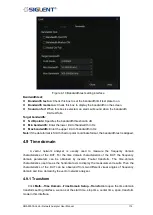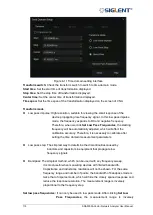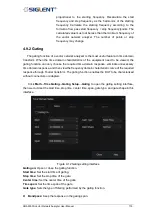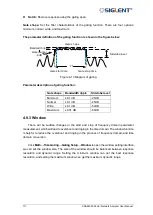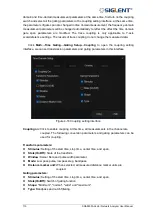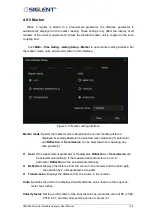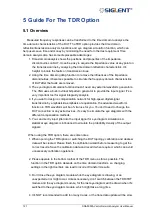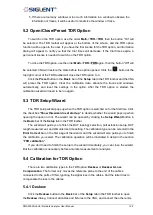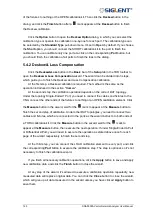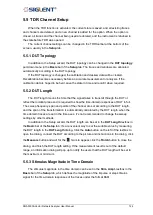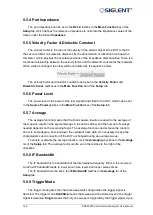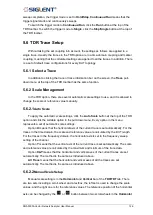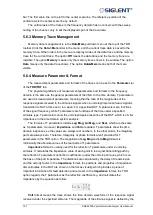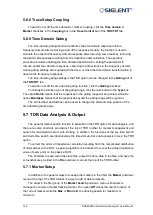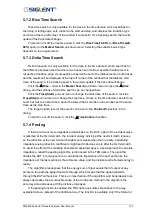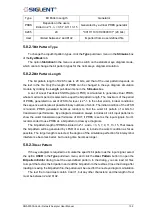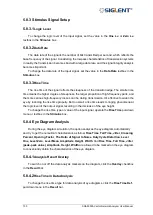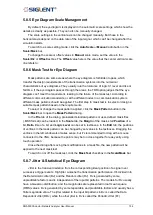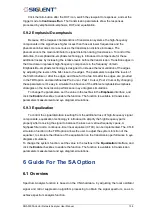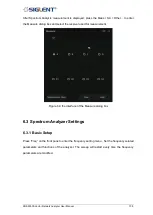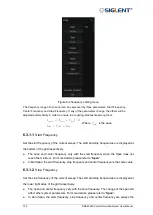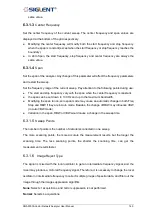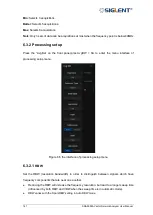
127 SNA5000A Vector Network Analyzer User Manual
bar: The first scale line on the left or the center scale line. The reference position of the
vertical axis is the center scale line by default.
The vertical axis of the traces in the frequency domain has no concern with the sweep
setting of the channel, only to set the displayed span of the trace data
.
5.6.3
Memory Trace Management
Memory trace management is in the
Data/Mem
pull-down menu at the top of the TDR
toolbar. Click the
Data->Mem
order in the menu, and the current trace data is saved to the
memory trace. Other orders in the menu are display modes of the data trace and the memory
trace for the current trace: The option
Off
means the data trace and the memory trace are
invisible. The option
Memory
means only the memory trace shows in the window. The option
Data
means only the data trace shows. The option
Data&Mem
means both of them are
visible.
5.6.4
Measure Parameter & Format
The measurement parameters and formats of the traces can be set in the
Parameter
tar
of the
TDR/TDT
tab.
The physical significance of measurement parameters and formats in the frequency
domain is the same as the general parameters of the VNA. In the time domain, T parameters
are used as measurement parameters, meaning that the ratio of the magnitudes of the
response signals received to the stimulus signals when a unit step/impulse stimulus signal is
transmitted to DUT at time zero, in a span. For a specified DUT, S parameters are functions
of the signal frequency, while T parameters are functions of the time under a specified
stimulus type. T parameters show the unit step/impulse response of the DUT, which is of vital
importance in the time domain system analysis.
The formats of T parameters include
Log Mag
,
Lin Mag,
and
Real
, which are the same
as S parameters; moreover,
Impedance
and
Volt
are added. T parameters show the time
domain responses, so the values are always real numbers. In the other words, the imaginary
parts are always zero. Therefore, Imaginary or phase formats aren't provided for T
parameters in the TDR option. The magnitude of
Log Mag
and
Lin Mag
formats is
intrinsically the absolute values of the real parts of T parameters.
Impedance
format is usually used for the reflection T parameters under a unit step
stimulus. It calculates the impedance value of each point in the signal transmitting path by
the reflection T parameters (reflection coefficients) under the unit step stimulus, which is on
the base of the port impedance. The distances are calculated by the delay of transmission
and the velocity factor. In the
Impedance
format, the positions and properties of impedance
discontinuities in the DUT are shown on the traces visually, which provides a piece of
important information for fault detection and removal. In the
Impedance
format, the TDR
option regards the T parameters as the reflection coefficients ρ, and calculates the
impedance by the equation as follow:
Volt
format means the trace shows the time domain waveform of the response signal
received under the specified stimulus. The magnitude of the stimulus signal is defined by the
Summary of Contents for SNA5000A Series
Page 2: ......


